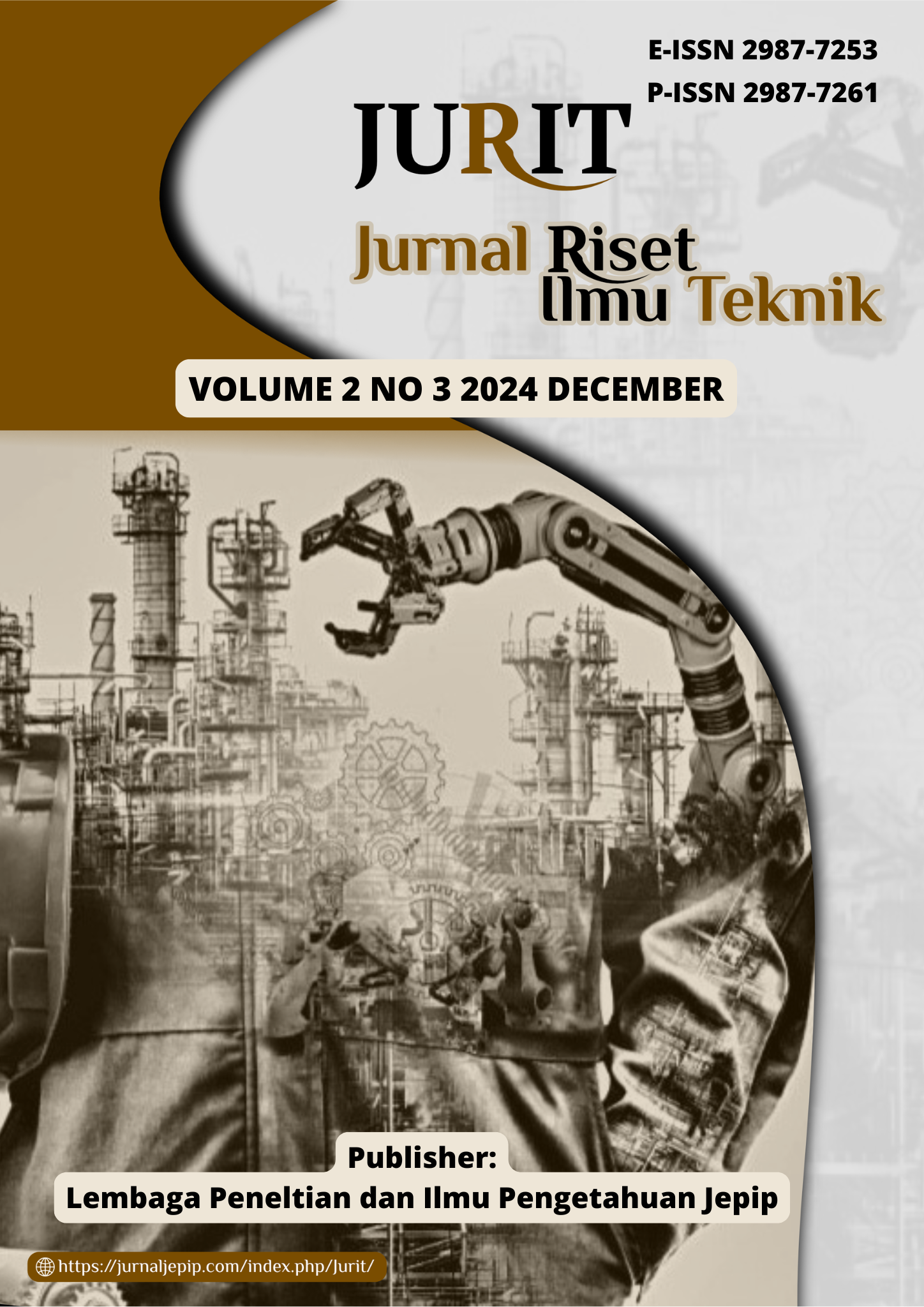Systematic Diagnosis of Quality Defects in Concrete Electricity Poles Through The New Seven Tools
DOI:
https://doi.org/10.59976/jurit.v2i3.130Abstract
This study investigates the root causes of quality defects in concrete electrical poles produced by PT. LMN using the New Seven Tools (NST) approach. The research employs a qualitative–descriptive case study to systematically identify, categorize, and analyze defect patterns arising from human, machine, method, material, and environmental factors. Data were obtained through field observation, interviews, and documentation, then processed using the NST framework comprising Affinity Diagram, Interrelationship Diagram, Tree Diagram, Matrix Diagram, Activity Network Diagram, and Process Decision Program Chart (PDPC). The findings indicate that lack of routine supervision and insufficient machine maintenance are the dominant causal factors driving product defects, with the Man and Machine categories scoring the highest in the Matrix analysis (18 and 17, respectively). Corrective actions prioritized include implementing regular inspection schedules, preventive maintenance programs, and environmental standardization to improve workflow efficiency and reduce defect rates. Furthermore, the Activity Network analysis identifies the evaporation process as the critical path contributing to extended production time, while PDPC results underscore the importance of balancing technical feasibility with cost-effective corrective strategies. The study concludes that the integration of human resource development, process standardization, and preventive maintenance can significantly enhance product reliability and align production performance with zero-defect manufacturing principles. This research provides both theoretical and practical contributions by validating the applicability of the New Seven Tools method for comprehensive quality improvement in the Indonesian manufacturing sector.
References
M. Naghavi, “Global burden of 288 causes of death and life expectancy decomposition in 204 countries and territories and 811 subnational locations, 1990–2021: a systematic analysis for the Global Burden of Disease Study 2021,” Lancet, vol. 403, no. 10440, pp. 2100–2132, 2024, doi: 10.1016/S0140-6736(24)00367-2.
H. Crompton, “Artificial intelligence in higher education: the state of the field,” Int. J. Educ. Technol. High. Educ., vol. 20, no. 1, 2023, doi: 10.1186/s41239-023-00392-8.
J. C. Navarro-Muñoz, “A computational framework to explore large-scale biosynthetic diversity,” Nat. Chem. Biol., vol. 16, no. 1, pp. 60–68, 2020, doi: 10.1038/s41589-019-0400-9.
Q. N. Hong, “Improving the content validity of the mixed methods appraisal tool: a modified e-Delphi study,” J. Clin. Epidemiol., vol. 111, pp. 49–59, 2019, doi: 10.1016/j.jclinepi.2019.03.008.
H. Hu, “AnimalTFDB 3.0: A comprehensive resource for annotation and prediction of animal transcription factors,” Nucleic Acids Res., vol. 47, 2019, doi: 10.1093/nar/gky822.
D. P. Fan, “Rethinking RGB-D Salient Object Detection: Models, Data Sets, and Large-Scale Benchmarks,” IEEE Trans. Neural Networks Learn. Syst., vol. 32, no. 5, pp. 2075–2089, 2021, doi: 10.1109/TNNLS.2020.2996406.
J. Pearl, “The seven tools of causal inference, with reflections on machine learning,” Commun. ACM, vol. 62, no. 3, pp. 54–60, 2019, doi: 10.1145/3241036.
N. Black, “Cannabinoids for the treatment of mental disorders and symptoms of mental disorders: a systematic review and meta-analysis,” Lancet Psychiatry, vol. 6, no. 12, pp. 995–1010, 2019, doi: 10.1016/S2215-0366(19)30401-8.
W. Sun, “A map of the inorganic ternary metal nitrides,” Nat. Mater., vol. 18, no. 7, pp. 732–739, 2019, doi: 10.1038/s41563-019-0396-2.
S. Barteit, “Augmented, mixed, and virtual reality-based head-mounted devices for medical education: Systematic review,” 2021. doi: 10.2196/29080.
J. P. T. Higgins, “A tool to assess risk of bias in non-randomized follow-up studies of exposure effects (ROBINS-E),” Environ. Int., vol. 186, 2024, doi: 10.1016/j.envint.2024.108602.
P. C. L. Silva, “COVID-ABS: An agent-based model of COVID-19 epidemic to simulate health and economic effects of social distancing interventions,” Chaos Solitons and Fractals, vol. 139, 2020, doi: 10.1016/j.chaos.2020.110088.
A. J. McGuinness, “A systematic review of gut microbiota composition in observational studies of major depressive disorder, bipolar disorder and schizophrenia,” 2022. doi: 10.1038/s41380-022-01456-3.
C. Chaccour, “Seven Defining Features of Terahertz (THz) Wireless Systems: A Fellowship of Communication and Sensing,” IEEE Commun. Surv. Tutorials, vol. 24, no. 2, pp. 967–993, 2022, doi: 10.1109/COMST.2022.3143454.
C. Devereux, “Extending the Applicability of the ANI Deep Learning Molecular Potential to Sulfur and Halogens,” J. Chem. Theory Comput., vol. 16, no. 7, pp. 4192–4202, 2020, doi: 10.1021/acs.jctc.0c00121.
M. De Veirman, “What Is Influencer Marketing and How Does It Target Children? A Review and Direction for Future Research,” 2019. doi: 10.3389/fpsyg.2019.02685.
F. Mo, “Recent Development of Aryl Diazonium Chemistry for the Derivatization of Aromatic Compounds,” 2021. doi: 10.1021/acs.chemrev.0c01030.
L. Herlitz, “The sustainability of public health interventions in schools: A systematic review,” 2020. doi: 10.1186/s13012-019-0961-8.
K. L. Lee, “The effect of digital supply chain on organizational performance: An empirical study in Malaysia manufacturing industry,” Uncertain Supply Chain Manag., vol. 10, no. 2, pp. 495–510, 2022, doi: 10.5267/j.uscm.2021.12.002.
M. Sekhon, “Development of a theory-informed questionnaire to assess the acceptability of healthcare interventions,” BMC Health Serv. Res., vol. 22, no. 1, 2022, doi: 10.1186/s12913-022-07577-3.
Z. L. Hu, “Bringing the Animal QTLdb and CorrDB into the future: Meeting new challenges and providing updated services,” Nucleic Acids Res., vol. 50, 2022, doi: 10.1093/nar/gkab1116.
Z. Cai, “Evolving an optimal kernel extreme learning machine by using an enhanced grey wolf optimization strategy,” Expert Syst. Appl., vol. 138, 2019, doi: 10.1016/j.eswa.2019.07.031.
K. L. Wyres, “Genomic surveillance for hypervirulence and multi-drug resistance in invasive Klebsiella pneumoniae from South and Southeast Asia,” Genome Med., vol. 12, no. 1, 2020, doi: 10.1186/s13073-019-0706-y.
M. Z. H. Khan, “Ultrasensitive detection of pathogenic viruses with electrochemical biosensor: State of the art,” 2020. doi: 10.1016/j.bios.2020.112431.
R. Sattar, “Meta-ethnography in healthcare research: a guide to using a meta-ethnographic approach for literature synthesis,” BMC Health Serv. Res., vol. 21, no. 1, 2021, doi: 10.1186/s12913-020-06049-w.
L. L. de Sousa, “DNA metabarcoding in diet studies: Unveiling ecological aspects in aquatic and terrestrial ecosystems,” 2019. doi: 10.1002/edn3.27.
S. K. K. Santu, “AutoML to Date and Beyond: Challenges and Opportunities,” 2022. doi: 10.1145/3470918.
G. Norman, “Negative pressure wound therapy for surgical wounds healing by primary closure,” Cochrane Database Syst. Rev., vol. 5, 2020, doi: 10.1002/14651858.CD009261.pub5.
C. J. Bartel, “A critical examination of compound stability predictions from machine-learned formation energies,” Npj Comput. Mater., vol. 6, no. 1, 2020, doi: 10.1038/s41524-020-00362-y.
M. Yazdani, “A grey combined compromise solution (CoCoSo-G) method for supplier selection in construction management,” J. Civ. Eng. Manag., vol. 25, no. 8, pp. 858–874, 2019, doi: 10.3846/jcem.2019.11309.
J. Peng, “Place Identity: How Far Have We Come in Exploring Its Meanings?,” 2020. doi: 10.3389/fpsyg.2020.00294.
D. M. Fernandes, “Severe Acute Respiratory Syndrome Coronavirus 2 Clinical Syndromes and Predictors of Disease Severity in Hospitalized Children and Youth,” J. Pediatr., vol. 230, pp. 23–31, 2021, doi: 10.1016/j.jpeds.2020.11.016.
A. Fattahi, “A systemic approach to analyze integrated energy system modeling tools: A review of national models,” 2020. doi: 10.1016/j.rser.2020.110195.
E. Sbidian, “Systemic pharmacological treatments for chronic plaque psoriasis: a network meta-analysis,” 2021. doi: 10.1002/14651858.CD011535.pub4.
L. P. (. Lin, “Could virtual reality effectively market slow travel in a heritage destination?,” Tour. Manag., vol. 78, 2020, doi: 10.1016/j.tourman.2019.104027.
C. Cortinovis, “A performance-based planning approach integrating supply and demand of urban ecosystem services,” Landsc. Urban Plan., vol. 201, 2020, doi: 10.1016/j.landurbplan.2020.103842.
D. A. P. Prabhakar, “A comprehensive review of friction stir techniques in structural materials and alloys: challenges and trends,” 2022. doi: 10.1016/j.jmrt.2022.08.034.
G. Solana-Lavalle, “Classification of PPMI MRI scans with voxel-based morphometry and machine learning to assist in the diagnosis of Parkinson’s disease,” Comput. Methods Programs Biomed., vol. 198, 2021, doi: 10.1016/j.cmpb.2020.105793.
Downloads
Published
How to Cite
Issue
Section
License
Copyright (c) 2024 Ikrimah Hilal, Emmy Liona, Dito Ranova

This work is licensed under a Creative Commons Attribution 4.0 International License.





















